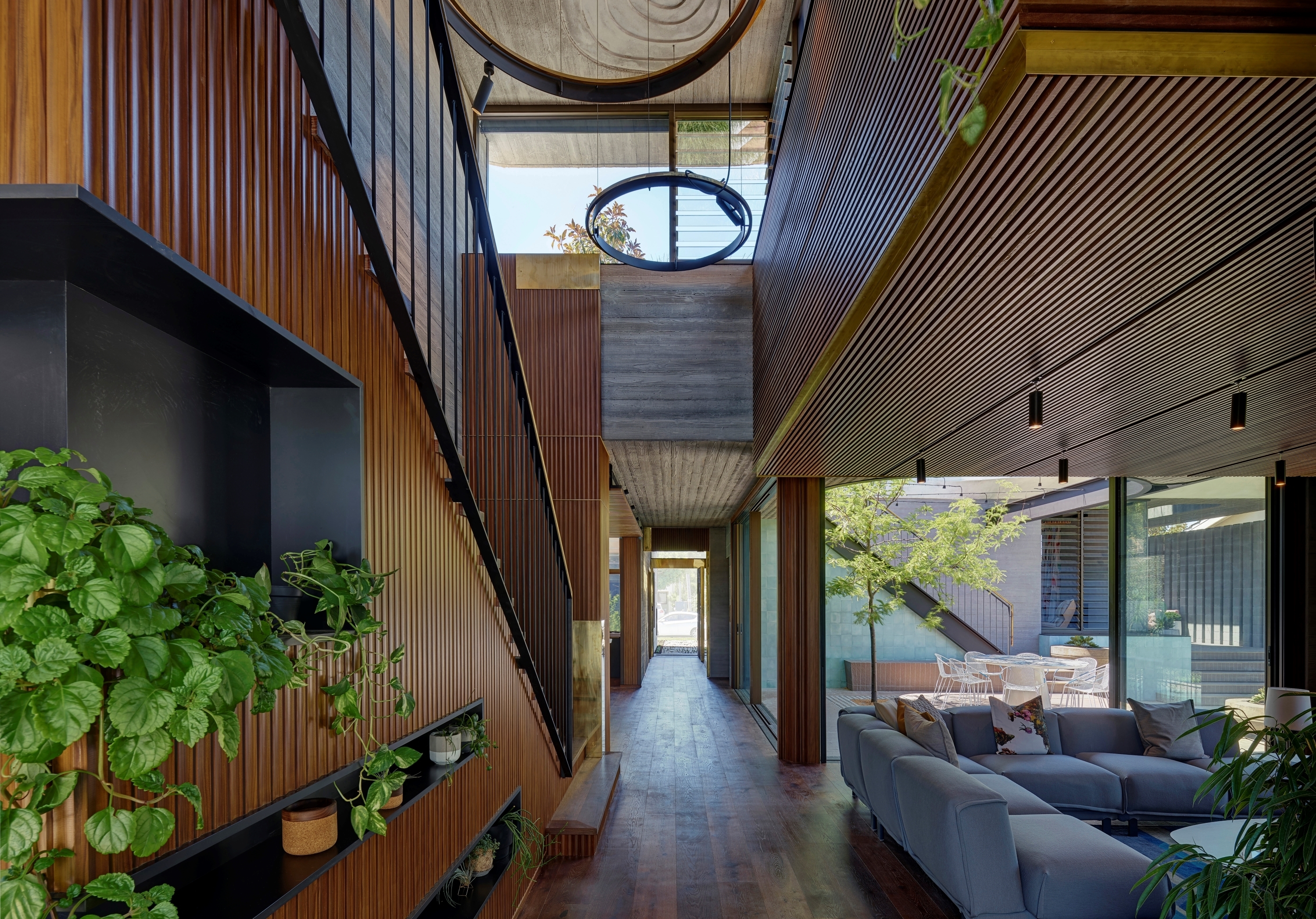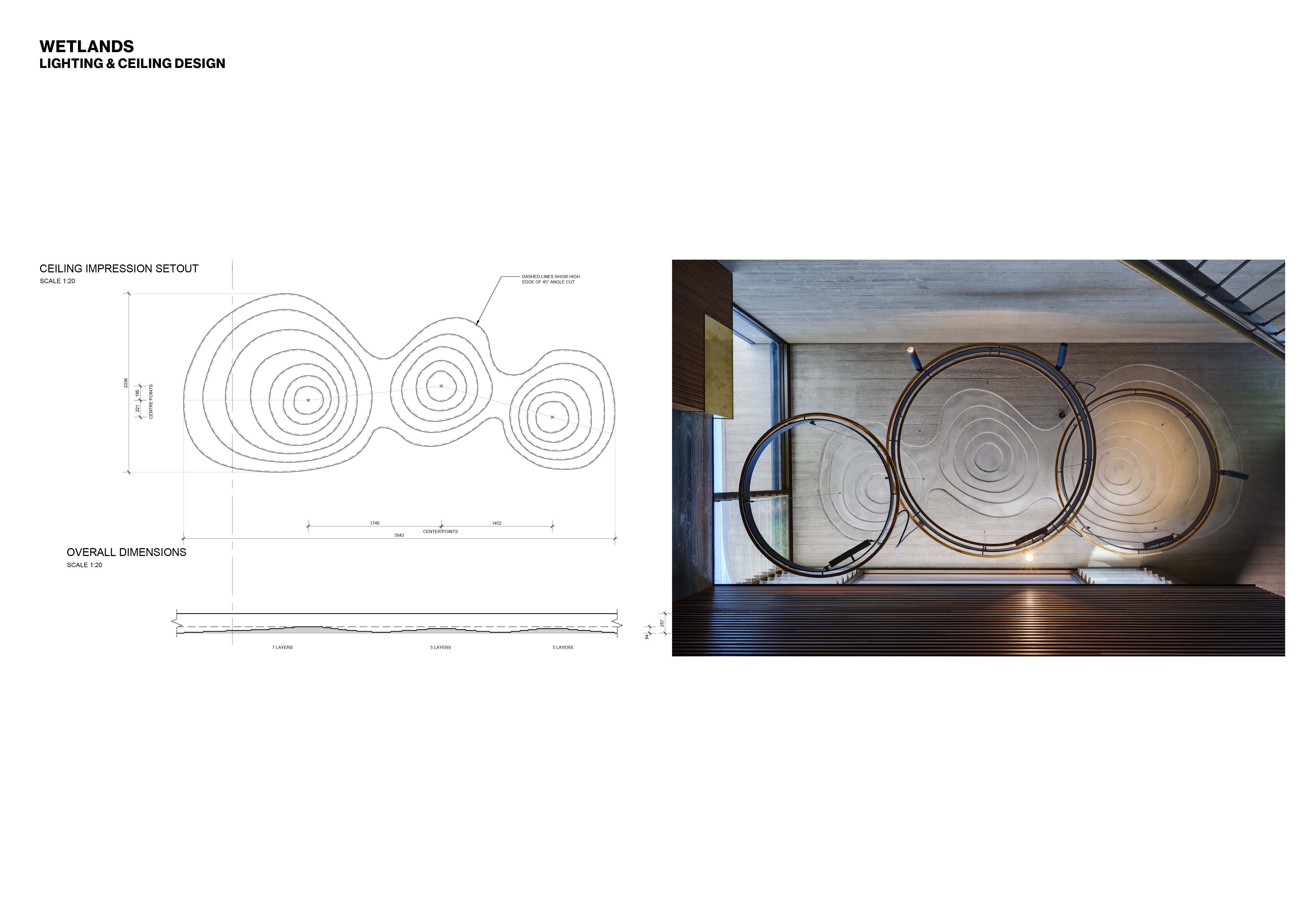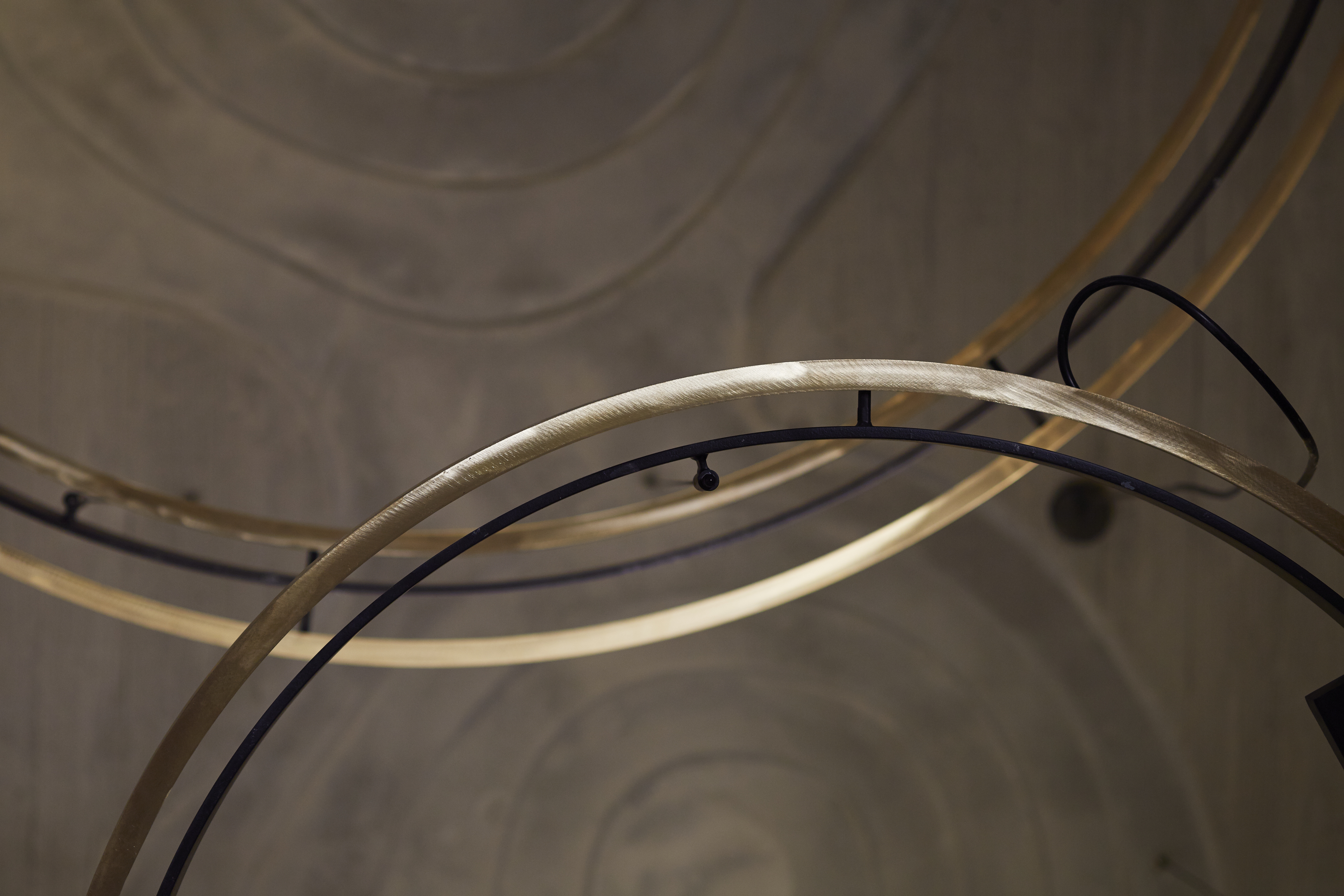Floreat
Ncoorenboro, Galup, Boojemooling, product design, concrete, brass, mild steel.
The three pendant lights in the main stair void of Roscommon House were specifically designed to capture and enhance the material qualities of the house. Constructed from brass and blackened steel, the materials used pick up on metals used throughout the house. The lights themselves wash light both down and up, highlighting the texture of the concrete walls and ceiling. The concrete ceiling has an impression cast in of a contoured shape rising to three high points, the centre of which locates the centres of each ring.
The design service provided by Neil Cownie included concept design, prototypes, detailed design, material selections, light fitting selection and co-ordination, fabrication co-ordination and installation.
CLIENT BRIEF
The custom design of the pendant lights and associated relief pattern in the concrete ceiling was just one part of the interior design of the whole house that contained many custom designed items of furniture and lighting.
The custom pendant lights needed to sit appropriately within the central stair void space in the bespoke interior of the house.
HISTORY OF PLACE AND PEOPLE
The Swan Coastal Plain was, prior to European occupation, an interconnected wetland with its creator believed by the Whadjuk Noongar people to have been the Rainbow Serpent known as the Waakal.
For thousands of years the lakes on the coastal plain had provided the Wadjuk Nooongar people with water and food. They were particularly important to them during and soon after the long dry summer, which reduced most lakes to ‘nothing more than swamps’. ‘The bulk of the diet comprised carbohydrate staples derived from fruits and seeds, bulbs and corms, underground root tubers, and starch-filled stems or rhizomes. Reed rhizomes, ground and made into “damper”, provided much of the daily bread.’ The ‘flag’ [reed] yun-jid is at its edible best in April and May, and the rush jeeta in June. Frogs, normally buried in the mud in the summer, and tortoises, were an important reliable source of protein and fat. Swans and ducks, more or less plentiful according to the season, were caught by hand (at moulting time) or hit with spear or boomerang, or patiently snared with a noose. (Source: History of Perth Lakes by H. Bekle & J. Gentilli).
With wetland ‘lakes’ in the central Perth area gradually infilled by the European settlers, by 1848 a committee had been appointed to evaluate the policy of draining the lakes completely. During this period and in the following decades the outer lakes, including lakes Monger and Herdsman, were left relatively undisturbed, but the moist land around them was subdivided into large blocks and used to grow dairy fodder and vegetables. ‘Lake Herdsman, being also at present remote from any part of the townsite available for occupation by the public, does not call for immediate attention; but when the time shall arrive for extending the building or suburban lots to it, the surface might then advantageously be drained or raised from the adjoining land.’ On the borders of the lakes had been established summer market gardens which, when properly looked after, yielded plentiful crops of melons, potatoes, carrots and other vegetables. During the winter months, however, they were completely covered with water and utterly useless.
The lakes at the rural margin of the earlier townsite or just within the Perth Road Board District (now the City of Stirling) were unaffected by settlement for a much longer time. Herdsman Lake was as yet unnamed and marked ‘large open swamp’ and Lake Monger, also unnamed, ‘open swamp’ in the first sketch map of land allocations at the Swan River Settlement drawn by Roe, the Surveyor-General, in 1829. Herdsman Lake soon became ‘The Great Lake’ for the colonists. Situated only 7 kilometres north-west of Perth, it was a favourite resort for duck shooters. The ‘Great Lakes’ and the much smaller Jackadder Lake are wetlands which still survive, although they are much altered by drainage, filling and ‘development’.
LANDSCAPE AND GEOLOGY
The fertile wetland areas of the Perth region were filled in by the early European settlers who considered the wetlands to be foul smelling swamps. Over time these fertile areas became market gardens populated by Perth’s Chinese community. The disconnection of the wetland areas is part cause of the treat to the Long-neck Turtle species.
The design of Wetlands custom lighting celebrates the history and significance of its location, amongst the formerly connected wetlands of the ‘Great Lakes District’, previously a place of an abundance of wildlife and a place of passage and encampment for indigenous people.
ARCHITECTURE AND DESIGN
Wetlands custom designed and fabricated pendant lights by Neil Cownie sit below and visually relate to the story within the profiled concrete ceiling over the main void space in the house. The pendants work together with the concrete ceiling to tell the story of the house’s location within the nearby wetlands, with its series of interlocking chain of swamps and waterbodies, named by Perth’s first European settlers as the ‘Great Lakes District’. Incorporating the large water bodies of Ngurgenboro (Herdsman Lake), Galup (Lake Monger) and Boojemooling (Hyde Park) and many others prior to the European settlers infilling of swamp lands and the gradual division of the chain through the introduction of roads and freeways. These wetlands were previously a place of an abundance of wildlife and a place of passage and encampment for local indigenous people.
Accolades
Design Institute of Australia WA
2017: Product Design - Commendation (Lighting)

























